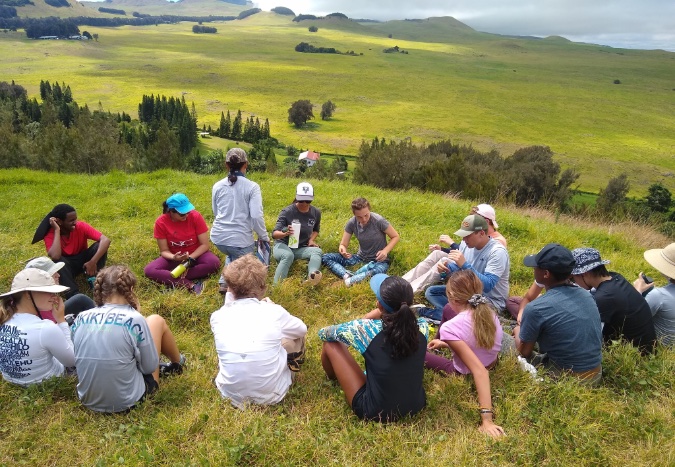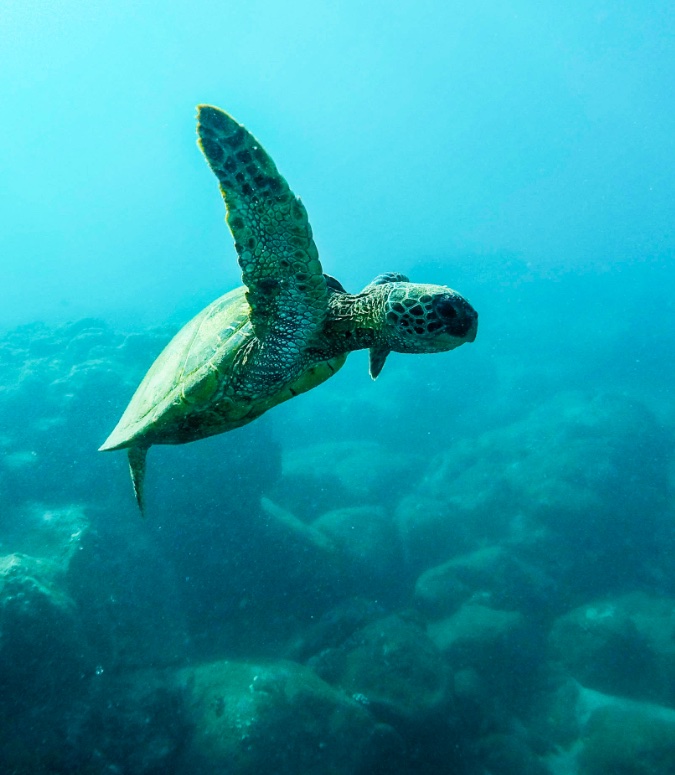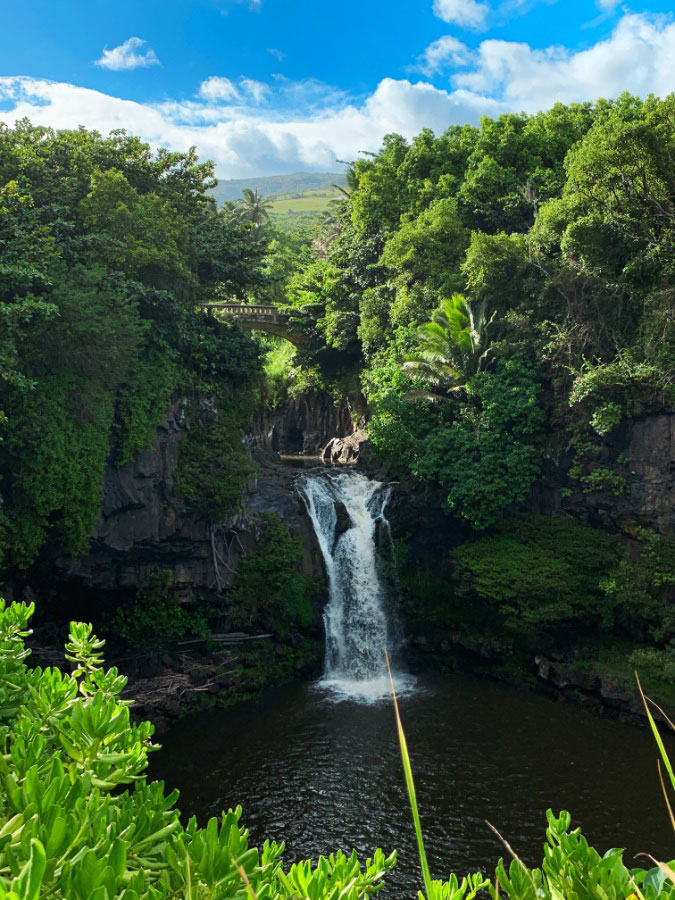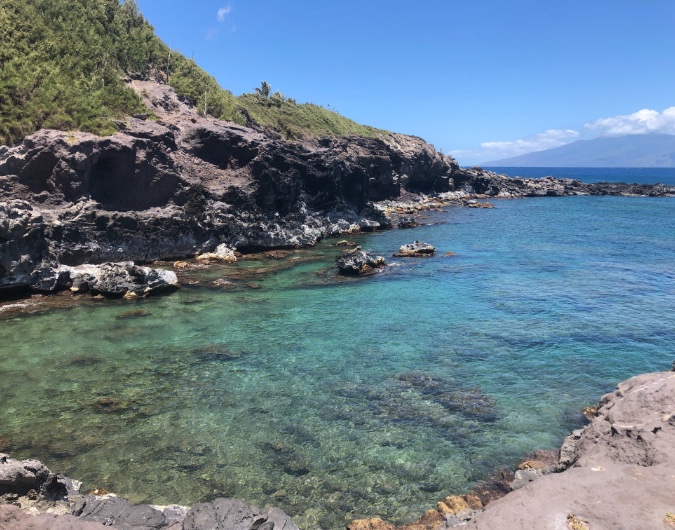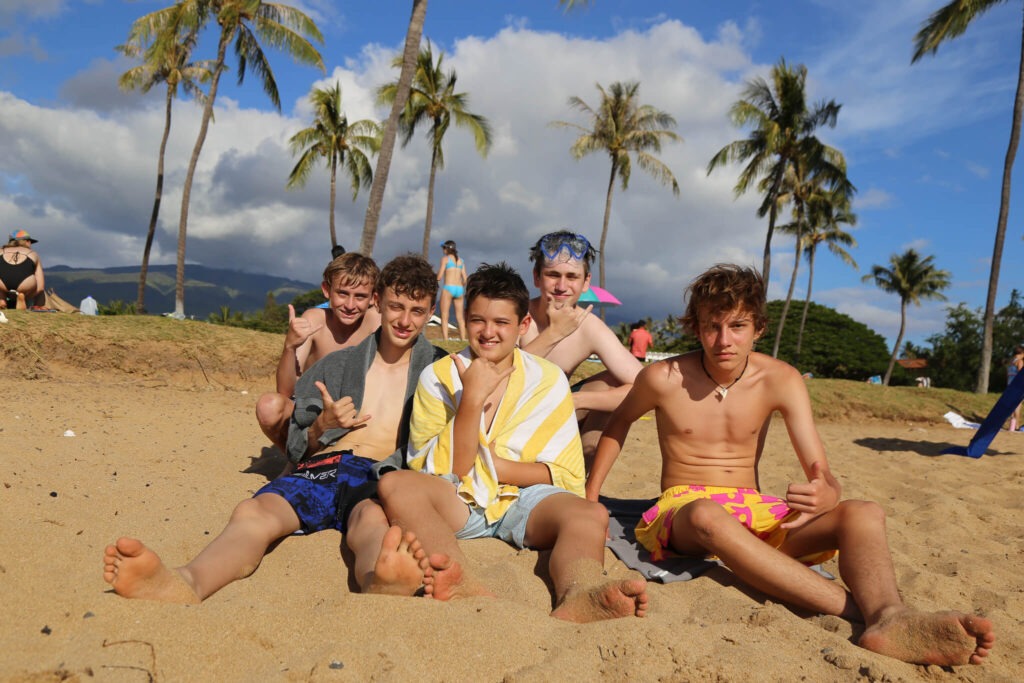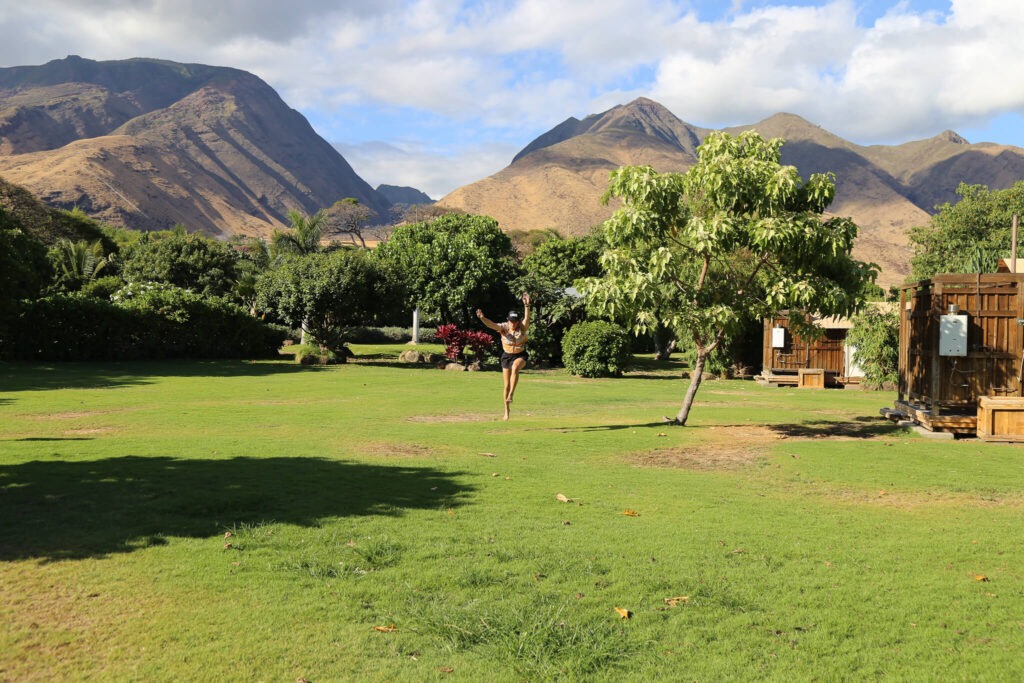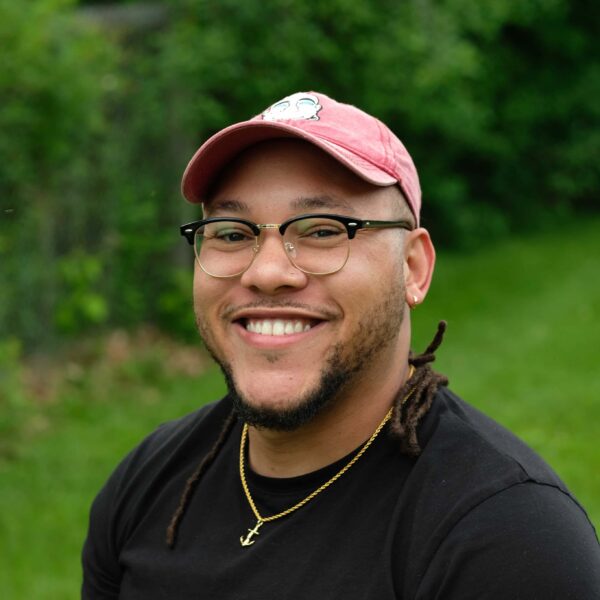Hawai’i
Environmental Service & Hawaiian Culture on the Big Island
With its incredible landscapes, biodiversity, and rich cultural heritage, Hawaii’s Big Island is the perfect paradise. This summer, experience the island’s remarkable ecosystems up close as you snorkel with manta rays off the Kona coast, explore the lush, tropical gardens and waterfalls of Hilo, and hike through inactive calderas and lava tubes in Hawai’i Volcanoes National Park. In Waimea and Pahala, learn the importance of the Hawaiian phrase Mālama ʻĀina, which means to care for and honor the land, as you engage in land-based service work with local nonprofit organizations committed to the protection and maintenance of the island’s natural areas and wildlife habitats.
- Highlights
• Work alongside Hawaiians to restore, maintain, and protect natural areas
• Hike through inactive calderas and lava tubes in Volcanoes National Park
• Stargaze atop Mauna Kea, Hawaii’s highest peak
Itinerary
This itinerary represents our best projection of the group’s schedule. However, we may implement changes designed to improve the quality of the program.
Meet your fellow student travelers and one or more of your leaders in Los Angeles, California, and fly together to Kona, Hawai'i. To learn more about how we organize travel, click here.
Head northeast to Waimea, the home of paniolos, cattle ranches, and rolling grasslands. Get to know your group and participate in an in-depth orientation on your time in Hawai’i. Partner with a local nonprofit organization dedicated to understanding and preserving ancient Hawaiian agricultural practices as you help plant and harvest native crops, clear invasive species, and learn about the island’s many ecosystems and climate zones. Hike to a nearby cinder cone to catch a glimpse of the expansive Kohala Field System and learn about how our partners are working hard to revitalize and conserve this land for future generations. In the afternoons after service, head to the beach for a swim or venture out for a hike in the forest near your accommodations.
Travel to the Big Island’s lush eastern coast, dotted with waterfalls, tropical rainforests, and beautiful beach parks. Take a break from your service activities while you sample fresh fruits and local eats at Hilo’s world-famous farmer’s market. Learn about how ancient Polynesians used celestial navigation to discover the islands while you stargaze atop Mauna Kea. Head out of town to see the towering ‘Akaka Falls, and enjoy some downtime at the beach with your group before heading to your next stop.
Settle into your cabins less than a mile away from Kilauea Caldera, the most active and researched volcano in the world. Explore the park from the top of Kilauea all the way down to the coastline as you hike through dormant volcanic craters, venture inside old lava tubes, and hunt for ancient Hawaiian petroglyphs. While here, lend a hand to local Hawaiians and nonprofit organizations working to preserve and protect the coastline and wildlife of the vast, remote Kaʻū region. During your free time, head to Punalu’u black sand beach to spot sea turtles, visit a local coffee mill or historical sugar plantation, or participate in a Hawaiian imu ceremony and luau.
For the end of your program, head to the calm waters of the Big Island’s western coast. Visit the spiritual sanctuary of Puʻuhonua o Hōnaunau to learn more about kapu, an ancient Hawaiian code of conduct. Soak up the last few days with your group as you explore the many shops, restaurants, and cafes of Kona town, and cap off your experience with a magical evening snorkel with manta rays, the gentle giants of the ocean.
Fly from Kona to Los Angeles with your group and a leader, then continue on to your final destination. To learn more about how we organize travel, click here.
Itinerary
This itinerary represents our best projection of the group’s schedule. However, we may implement changes designed to improve the quality of the program.
Meet your fellow student travelers and one or more of your leaders in Los Angeles, California, and fly together to Kona, Hawai'i. To learn more about how we organize travel, click here.
Head northeast to Waimea, the home of paniolos, cattle ranches, and rolling grasslands. Get to know your group and participate in an in-depth orientation on your time in Hawai’i. Partner with a local nonprofit organization dedicated to understanding and preserving ancient Hawaiian agricultural practices as you help plant and harvest native crops, clear invasive species, and learn about the island’s many ecosystems and climate zones. Hike to a nearby cinder cone to catch a glimpse of the expansive Kohala Field System and learn about how our partners are working hard to revitalize and conserve this land for future generations. In the afternoons after service, head to the beach for a swim or venture out for a hike in the forest near your accommodations.
Travel to the Big Island’s lush eastern coast, dotted with waterfalls, tropical rainforests, and beautiful beach parks. Take a break from your service activities while you sample fresh fruits and local eats at Hilo’s world-famous farmer’s market. Learn about how ancient Polynesians used celestial navigation to discover the islands while you stargaze atop Mauna Kea. Head out of town to see the towering ‘Akaka Falls, and enjoy some downtime at the beach with your group before heading to your next stop.
Settle into your cabins less than a mile away from Kilauea Caldera, the most active and researched volcano in the world. Explore the park from the top of Kilauea all the way down to the coastline as you hike through dormant volcanic craters, venture inside old lava tubes, and hunt for ancient Hawaiian petroglyphs. While here, lend a hand to local Hawaiians and nonprofit organizations working to preserve and protect the coastline and wildlife of the vast, remote Kaʻū region. During your free time, head to Punalu’u black sand beach to spot sea turtles, visit a local coffee mill or historical sugar plantation, or participate in a Hawaiian imu ceremony and luau.
For the end of your program, head to the calm waters of the Big Island’s western coast. Visit the spiritual sanctuary of Puʻuhonua o Hōnaunau to learn more about kapu, an ancient Hawaiian code of conduct. Soak up the last few days with your group as you explore the many shops, restaurants, and cafes of Kona town, and cap off your experience with a magical evening snorkel with manta rays, the gentle giants of the ocean.
Fly from Kona to Los Angeles with your group and a leader, then continue on to your final destination. To learn more about how we organize travel, click here.
Leaders
Meet some of our featured leaders. Please note that these may not be your leaders for the program.
Leaders
Meet some of our featured leaders. Please note that these may not be your leaders for the program.
Hawai'i is the birthplace of surfing, hula, and the ukulele, among countless other contributions to global culture. The most remote island chain on Earth, these islands were first settled by Polynesian explorers 1,500 years ago; since then, many waves of immigration have followed. The islands were annexed by the U.S. in 1898, against the will of Native Hawaiians, who proudly maintain their cultural traditions and language to this day. From coral reefs and fresh lava flows, to snow capped volcanic peaks, the landscape offers incredible variety and endless opportunities for exploration.
English is the official language of Hawai'i, though most of our service partners and contacts are Native Hawaiian and proudly speak Hawaiian. You will have an opportunity to learn phrases and practice the Hawaiian language throughout the program.
Hawai'i is home to the majority of the climatic zones found on Earth, from tropical rainforests to alpine tundra. Expect temperatures ranging from approximately 85°F/30°C to 65°F/18°C. At high elevations, the temperature can dip to as low as 50°F/10°C. Prepare for some windy days on the south side of the island, and some wet days on the east coast.
Hawaiian food contains a fusion of native crops and cooking techniques brought by the earliest Polynesian settlers, as well as Portuguese, American, Chinese, Japanese, and Korean immigrants. Expect to try local staples like taro and passionfruit alongside modern dishes like poke and spam musubi.
Hawai'i is the birthplace of surfing, hula, and the ukulele, among countless other contributions to global culture. The most remote island chain on Earth, these islands were first settled by Polynesian explorers 1,500 years ago; since then, many waves of immigration have followed. The islands were annexed by the U.S. in 1898, against the will of Native Hawaiians, who proudly maintain their cultural traditions and language to this day. From coral reefs and fresh lava flows, to snow capped volcanic peaks, the landscape offers incredible variety and endless opportunities for exploration.
English is the official language of Hawai'i, though most of our service partners and contacts are Native Hawaiian and proudly speak Hawaiian. You will have an opportunity to learn phrases and practice the Hawaiian language throughout the program.
Hawai'i is home to the majority of the climatic zones found on Earth, from tropical rainforests to alpine tundra. Expect temperatures ranging from approximately 85°F/30°C to 65°F/18°C. At high elevations, the temperature can dip to as low as 50°F/10°C. Prepare for some windy days on the south side of the island, and some wet days on the east coast.
Hawaiian food contains a fusion of native crops and cooking techniques brought by the earliest Polynesian settlers, as well as Portuguese, American, Chinese, Japanese, and Korean immigrants. Expect to try local staples like taro and passionfruit alongside modern dishes like poke and spam musubi.
What to Expect
Review specific program expectations here. For more general information:
During your time in Hawai'i, you can expect to work for approximately 20-30 hours on land-based restoration projects. To learn more about our Service programs click here.
Pursue an independent project and explore an aspect of local culture of particular interest to you—become an expert on sea turtles, teach the group Hawaiian phrases, or interview one of our service partners, for example.
To help students fully engage and immerse themselves in the Putney travel experience, we do not allow cell phones, tablets, or laptops on our Middle School programs. Students may have their cell phones during travel to and from the program. During in-country orientation, leaders facilitate a call home, then collect and securely store all phones until departure day. Throughout the program, students have the opportunity for a weekly call home according to a pre-arranged schedule. For more details, please see our FAQ.
This is a moderately active summer travel program, and almost all of your time will be spent outside. You do not need to be at peak fitness to participate, but it is important that you have a desire to be physically active, and that you are excited about trying all activities.
Depending on weather conditions, this program may visit one high-altitude destination—Mauna Kea, which reaches an elevation of 9,000 feet/2,743 meters.
In Waimea, we stay in rooms of 2–4 in a large, shared house on Hawaii Preparatory Academy’s Campus with shared kitchens, bathrooms, and ample common space. In Hilo, we stay in double rooms with private baths at a comfortable seaside hotel with a pool and restaurant. In Volcanoes, we stay in comfortable, 3-person cabins on a campground just outside the entrance to the National Park. And in Kona, we stay in comfortable, dormitory-style rooms of 4–8 at a locally owned hostel. Students are separated according to gender at all accommodations. Students have access to common and outdoor spaces at all of our accommodations for group meetings, working on projects, socializing, etc. Leaders reside with students throughout the program.
In Waimea, we take most of our meals at the campus cafeteria with occasional dinners out on the town. We often make and pack our own lunches at other stops throughout the program, and often enjoy breakfast and dinner in small Hawaiian establishments.
What to Expect
Review specific program expectations here. For more general information:
During your time in Hawai'i, you can expect to work for approximately 20-30 hours on land-based restoration projects. To learn more about our Service programs click here.
Pursue an independent project and explore an aspect of local culture of particular interest to you—become an expert on sea turtles, teach the group Hawaiian phrases, or interview one of our service partners, for example.
To help students fully engage and immerse themselves in the Putney travel experience, we do not allow cell phones, tablets, or laptops on our Middle School programs. Students may have their cell phones during travel to and from the program. During in-country orientation, leaders facilitate a call home, then collect and securely store all phones until departure day. Throughout the program, students have the opportunity for a weekly call home according to a pre-arranged schedule. For more details, please see our FAQ.
This is a moderately active summer travel program, and almost all of your time will be spent outside. You do not need to be at peak fitness to participate, but it is important that you have a desire to be physically active, and that you are excited about trying all activities.
Depending on weather conditions, this program may visit one high-altitude destination—Mauna Kea, which reaches an elevation of 9,000 feet/2,743 meters.
In Waimea, we stay in rooms of 2–4 in a large, shared house on Hawaii Preparatory Academy’s Campus with shared kitchens, bathrooms, and ample common space. In Hilo, we stay in double rooms with private baths at a comfortable seaside hotel with a pool and restaurant. In Volcanoes, we stay in comfortable, 3-person cabins on a campground just outside the entrance to the National Park. And in Kona, we stay in comfortable, dormitory-style rooms of 4–8 at a locally owned hostel. Students are separated according to gender at all accommodations. Students have access to common and outdoor spaces at all of our accommodations for group meetings, working on projects, socializing, etc. Leaders reside with students throughout the program.
In Waimea, we take most of our meals at the campus cafeteria with occasional dinners out on the town. We often make and pack our own lunches at other stops throughout the program, and often enjoy breakfast and dinner in small Hawaiian establishments.
A Day in the Life: Waimea
- Morning
- Afternoon
- Evening
A Day in the Life:
Waimea
- Morning
- Afternoon
- Evening

Program Directed by
If you have questions or would like to talk further about this program, please get in touch!





